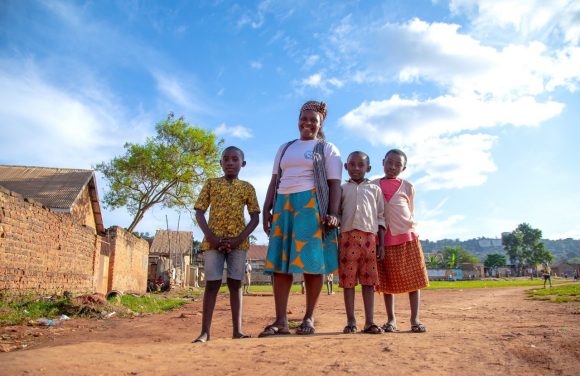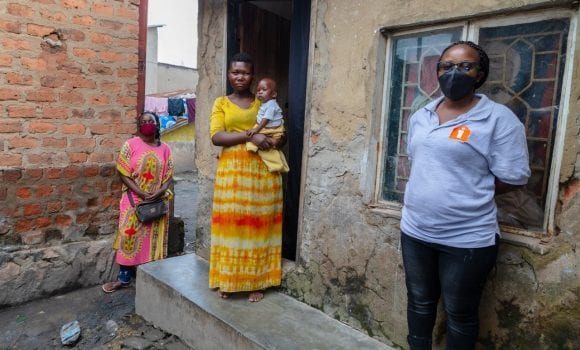
The story starts with five exceptional people.
Maria Ahlström-Bondestam is a member of one of the largest and most prominent industrial families in Finland. She’s also the Co-founder & Chair of the Eva Ahlström Foundation, wherein she rallies her family members to focus their wealth and networks on areas where they can do the most good.
Lucy Buck and Christopher Muwanguzi are the leaders behind the Child’s i Foundation, an organization working to support the safe return of children into families and communities while also working with the government to create alternatives that prevent children from living in and entering institutional care in Uganda.
Nina Hoas is a philanthropy advisor and Nalini Tarakeshwar is an Optimus Foundation program director. Both work in our firm and together they connect philanthropists with programs and people, allowing them to achieve positive impact at scale with their wealth and social investments.
Building up to the meet cute
Lucy started the Child’s i Foundation in 2008. She was moved by the state of child care in Uganda, where over 50,000 children are growing up in orphanages. Most have existing families who were convinced that institutional care offers a better life, which is the opposite of true. Lucy knew that addressing the issue would require shifting attitudes – in the communities that believe orphanages offer better support than families, the orphanages that propagate this myth, the volunteer tourists who fuel it, and the governments who allow it. She also knew she couldn’t do it alone.
She met Nina at a UBS Global Philanthropy Forum along with a couple of hundred philanthropists and change makers. Immediately, Lucy knew Nina was someone she had to stay in touch with. “She was so passionate,” recalls Lucy “and keen to help her clients.”
Nina and Maria met during a study on philanthropy in the Nordic region. The two found they had a lot in common – both are instigators, in the best possible way. They’re good at gathering people behind shared objectives and they’re not afraid to be proactive.
Then Nina invited Maria on a philanthropy insight trip where she learned the full extent of the problems with orphanages, an expertise Nalini holds as the program head for Child Protection at the UBS Optimus Foundation. Maria came home and, together with the Eva Ahlström foundation board, decided to dig further into the issue.
“I don’t believe in giving donations,” says Maria, “This is an investment in a child’s future, into them becoming a grounded, responsible adult and I apply the same due diligence here as I would to any other investment.” She knew that Nina had the same philosophy. What she didn’t know was that Nina already had a network of philanthropists looking into the issue and Nalini a range of organizations addressing it.
In the meantime, Lucy had begun partnering with UBS Optimus Foundation and received technical advice from Nalini on everything from monitoring and evaluating results to scaling program impact. Lucy also began the process of structuring the organization to be both effective and sustainable.
She’d also met Christopher, a Ugandan who had been training social workers in the UK. Together, they had great success in the district of Tororo, Uganda. Child’s i had helped existing families find ways to support their children and prevent separation, worked with local governments and social workers and trained local community members to support.
Not a single child entered institutional care in Tororo after their start and they were able to place all children from one pre-existing orphanage with their families or in loving homes. Christopher and Lucy started thinking of other places where the Tororo blueprint could be duplicated. But first, they’d need support.

The beginning of a Philanthropic Collaborative
The UBS Global Philanthropists Community is one of the largest philanthropic communities in the world. And it’s one of the only places where these five could have come together.
Nina and Nalini organized for Lucy and Christopher to share their knowledge and success around child care reform with the Global Philanthropists Community members. Through these meetings, Maria's Finnish family, a Swedish family and a Norwegian-Finnish family decided to work together in a funding Collective they called the Co-Nordic Collaborative.
"Collaboration can be a challenging task," says Maria, “but you can’t achieve lasting, systemic change alone. The Global Philanthropists Community and Philanthropy Services at UBS provided access to Nina, an independent advisor, to form and drive the collective forward. And the partnership with UBS Optimus Foundation and Child's i allowed us to learn and invest in the right approach.”
With the support of the co-Nordic Collaborative, as well as ongoing support from Nalini and UBS Optimus Foundation, Child’s i began community development in a second district of Uganda – Mpigi. There, they aim to stop 12,000 children from being exploited, separated from their families and/or lured into institutional care. And they don’t intend to stop at Mpigi.
"This Collaborative has given us the power to do more, faster. Sharing our vision with the donor collaborative and then bringing together their ideas, strategic thinking and financial resources to help shape our strategy was a step up for our organization," says Christopher.
And for all of them, and UBS, this is just the start of a growing community wherein funding partners work together to allow for the deep change that needs to happen in the fight for child care reform.
The takeaway
This story is about two types of success. The first is one we often write about – addressing pressing challenges with smart, systemic-change. The second is a message that isn’t stated enough – people have great capacity to do good. And there is strength in numbers. By coming together, we can achieve the lasting change the world needs.
Institutionalized care versus Family Based Care Reform
Lack of awareness about the concerns associated with institutionalized care has resulted in many well-intentioned donors continuing to fuel a system that does not always have the intended effect. Here are some facts.
- Globally, there are at least 2.7 million children in orphanages and institutionalized care (UNICEF, 2007).
- The actual number is likely much higher due to poor reporting and unofficial institutions.
- An estimated four out of every five children in institutional care have at least one living parent (Save the Children, 2009
).
- Poverty, education and healthcare are some of the main factors that lead families to believe their children will have better lives in institutional care.
- Institutional care can, and often does, have a devastating impact on brain development, particularly in early childhood development (UNICEF, 2017).
If you’re interested in knowing more about Family Based Care Reform and innovative philanthropy, visit here.
You may also like:
You may also like:

